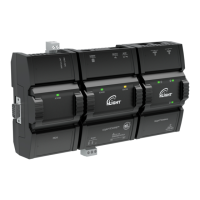Networking Basics
When manually configuring the TCP/IP interface on an ECLYPSE IP controller (the DHCP option is not used), an IP ad-
dress, subnetwork mask, and a default gateway are required in the Network Settings.
IP Addressing
The most widely used internet addressing scheme is IPv4. It codes an IP address in 32 bits.
An IPv4 address is made up of two parts defined by a subnetwork mask; the network portion (which identifies a specific
network or subnetwork) and the host portion (which identifies a specific device).
About the Subnetwork Mask
Devices on the same sub-network can address IP packets to each other directly without routing. The range of IP ad-
dresses available in a sub-network is defined by the subnetwork mask. This is also called the subnetwork mask’s ‘address
space’. The subnetwork mask is coded in 32 bits as follows.
An IP packet addressed to a device on another network portion will have to be routed through the router’s WAN port as
such an address is not local. BACnet/IP broadcast discovery messages such as “Who-Is” do not pass through network
routers that separate subnetworks. This means that BACnet/IP controllers on different subnetworks will not normally com-
municate with each other.
BBMD allows broadcast message to pass through a router: on each subnet, a single device has BBMD enabled. Each
BBMD device ensures BACnet/IP connectivity between subnets by forwarding broadcast messages found on its subnet-
work to each other, and then onto the local subnetwork as a broadcast message. See BBMD Settings.
Network Class CIDR Subnetwork Mask Block
Size
Number of Subnetworks
according to the Network Type
Number of Hosts
according to the Network Type
Class A Class B Class C Class A Class B Class C
←Class A Network→
/8 255.0.0.0 256 1 16777214
/9 255.128.0.0 128 2 8388606
/10 255.192.0.0 64 4 4194302
/11 255.224.0.0 32 8 2097150
/12 255.240.0.0 16 16 1048574
/13 255.248.0.0 8 32 525286
/14 255.252.0.0 4 64 262142
/15 255.254.0.0 2 128 131070
←Class B Network→
/16 255.255.0.0 256 256 1 65534 65534
/17 255.255.128.0 128 512 2 32766 32766
/18 255.255.192.0 64 1024 4 16382 16382
/19 255.255.224.0 32 2048 8 8190 8190
/20 255.255.240.0 16 4096 16 4094 4094
/21 255.255.248.0 8 8192 32 2046 2046
/22 255.255.252.0 4 16384 64 1022 1022
/23 255.255.254.0 2 32768 128 510 510
←Class C Network→
/24 255.255.255.0 256 65536 256 1 254 254 254
/25 255.255.255.128 128 131072 512 2 126 126 126
/26 255.255.255.192 64 262144 1024 4 62 62 62
/27 255.255.255.224 32 524288 2048 8 30 30 30
/28 255.255.255.240 16 1048576 4096 16 14 14 14
/29 255.255.255.248 8 2097152 8192 32 6 6 6
/30 255.255.255.252 4 4194304 16384 64 2 2 2
IPv4 Communication Fundamentals
14
nLight ECLYPSE

